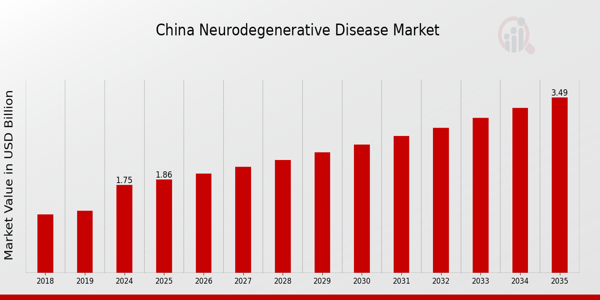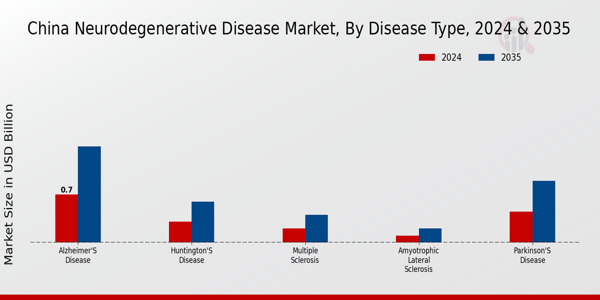China Neurodegenerative Disease Market Overview
As per MRFR analysis, the China Neurodegenerative Disease Market Size was estimated at 1.66 (USD Billion) in 2023. The China Neurodegenerative Disease Market Industry is expected to grow from 1.75(USD Billion) in 2024 to 3.49 (USD Billion) by 2035. The China Neurodegenerative Disease Market CAGR (growth rate) is expected to be around 6.487% during the forecast period (2025 - 2035)
Key China Neurodegenerative Disease Market Trends Highlighted
In China, the neurodegenerative disease market is significantly influenced by an aging population, as the country faces a notable increase in age-related health issues. The government has recognized neurodegenerative diseases as a major public health concern, prompting increased funding for research and development. This initiative focuses on conditions such as Alzheimer's disease and Parkinson's disease, which are prevalent in the elderly demographic. The rising prevalence of these disorders is a key market driver, coupled with the growing awareness of early diagnosis and treatment options.
There are substantial opportunities to be explored in China’s neurodegenerative disease market, particularly in the fields of drug development and innovative therapies.Biopharmaceutical companies are investing in novel therapeutic solutions, while local startups are emerging with unique approaches, driven by advancements in biotechnology and artificial intelligence. Moreover, collaborations between academic institutions and pharmaceutical companies are becoming common, fostering innovation and knowledge sharing. This collaborative environment is essential for addressing the complex challenges posed by neurodegenerative diseases.
In recent times, there has been a trend towards personalized medicine within this market. With the advancement in genomics and biomarker identification, treatments are becoming more targeted.Additionally, China is seeing a rise in the demand for supportive care services and rehabilitation facilities, which aligns with the broader global trend towards holistic care for patients with neurodegenerative disorders. These trends reflect a comprehensive approach to managing neurodegenerative diseases, illustrating a shift toward patient-centric models that aim to improve quality of life for individuals affected by these conditions. This patient-focused model is expected to drive further growth in the region’s healthcare landscape.

Source: Primary Research, Secondary Research, Market Research Future Database and Analyst Review
China Neurodegenerative Disease Market Drivers
Aging Population in China
The China Neurodegenerative Disease Market Industry is expanding as a result of the country's aging population. According to data from the National Bureau of Statistics, the number of people aged 60 and above is predicted to reach 487 million by 2050, which means that neurological disorders like Parkinson's and Alzheimer's would become more common. According to research, between 6.5% and 16.5% of those 65 and older have Alzheimer's disease, which is in line with the growing number of senior people.
As a result of the ongoing documentation and investigation of these patterns by reputable institutions such as the Chinese Academy of Medical Sciences, neurodegenerative disorders will likely receive more attention in the future. Additionally, government programs for health and elder care have made it possible to better support research and development for therapies that target neurodegenerative diseases, which has fueled market expansion.
Rising Awareness and Diagnosis Improvement
In recent years, there has been an increased awareness of neurodegenerative diseases in China, resulting in improved diagnosis and treatment options within the China Neurodegenerative Disease Market Industry. Reports indicate that awareness campaigns, often led by health organizations such as the China Alzheimer's Disease Association, have increased diagnostic rates significantly.
This boost is evident from a 30% increase in reported Alzheimer's cases over the last five years due to better screening and public awareness programs.As detection improves, healthcare providers are becoming more aware of the need for intervention and therapeutic options, leading to an expanding market for neurodegenerative treatments and medications.
Advancements in Biotechnology and Pharmaceuticals
Advancements in biotechnology and pharmaceuticals are driving innovation in the China Neurodegenerative Disease Market Industry. The increasing number of biotechnology firms and research institutions specializing in regenerative medicine in cities like Beijing and Shanghai showcases a competitive landscape that fosters development. The China National Pharmaceutical Group is one such established organization that invests heavily in the Research and Development of neurodegenerative treatments.
Moreover, the acceleration of clinical trials for novel drug candidates in the field has been evident, with over 50 ongoing trials in China focusing on neurodegenerative diseases according to the Chinese Clinical Trial Registry. Such advancements not only encourage further investment in the market but also lead to the timely delivery of cutting-edge therapies to patients, propelling industry growth.
China Neurodegenerative Disease Market Segment Insights
Neurodegenerative Disease Market Disease Type Insights
The China Neurodegenerative Disease Market has emerged as a critical focus area within the healthcare sector, particularly considering the growing prevalence of various conditions categorized under Disease Type. The market exhibits considerable segmentation, with conditions like Alzheimer's Disease, Parkinson's Disease, Multiple Sclerosis, Amyotrophic Lateral Sclerosis, and Huntington's Disease being particularly significant. Alzheimer's Disease continues to attract attention due to its substantial impact on an aging population, presenting challenges for families and caregivers, thus necessitating innovative treatment solutions and supportive care systems, which the market is working to address.
On the other hand, Parkinson's Disease, known for its motor symptoms and progressive nature, demands ongoing research for improved neuroprotective therapies, which reflects a strong market trend toward innovative drug development and patient management solutions. Multiple Sclerosis, an autoimmune disorder affecting the central nervous system, is increasingly recognized in China, prompting a need for effective therapies and lifestyle adaptations among the affected population. Meanwhile, Amyotrophic Lateral Sclerosis is gaining significance, as awareness and advocacy for better supportive care and medical advancements continue to evolve.
Huntington's Disease, though relatively less prevalent, nonetheless poses considerable challenges for affected individuals and their families, driving research into genetic interventions and comprehensive care strategies. Overall, the China Neurodegenerative Disease Market segmentation highlights the importance of tailored medical approaches and the requirement for advancements in both healthcare infrastructure and patient-centered strategies, ensuring that diverse needs across different disease types are adequately addressed.
The rise in diagnosed cases and ongoing demographic shifts fosters an environment ripe with opportunities for healthcare providers and pharmaceutical companies alike, positioning the market for sustained growth and innovation in combating neurodegenerative diseases.

Source: Primary Research, Secondary Research, Market Research Future Database and Analyst Review
Neurodegenerative Disease Market Diagnosis Method Insights
The Diagnosis Method segment within the China Neurodegenerative Disease Market is crucial in determining the presence and extent of such disorders. Neurological Examination plays a vital role, providing clinicians with immediate insights based on clinical symptoms and motor skills assessment. Imaging Techniques, which include Magnetic Resonance Imaging and Computed Tomography, are essential in visualizing brain changes, helping to identify conditions such as Alzheimer's and Parkinson's disease.
Cerebrospinal Fluid Analysis enables the detection of biomarkers associated with neurodegeneration, offering a critical window into the underlying pathological processes.Electrophysiological Tests, including EEG and EMG, assist in evaluating nerve and brain activity, thereby supporting diagnosis and monitoring. Collectively, these methodologies are integral for accurate diagnosis, which is essential for effective treatment plans and improving patient outcomes in China. The increasing prevalence of neurodegenerative diseases in the aging population further emphasizes the need for innovative and efficient diagnostic approaches in this segment.
As the China Neurodegenerative Disease Market continues to evolve, advancements in these diagnostic methods are expected to enhance the accuracy and speed of neurodegenerative disease identification.
Neurodegenerative Disease Market Treatment Type Insights
The China Neurodegenerative Disease Market, particularly in the Treatment Type segment, is poised for significant growth as it encompasses crucial areas like Medication, Therapy, Rehabilitation, and Surgical Interventions. Each of these areas plays an essential role in addressing the complexities of neurodegenerative disorders, which are increasingly prevalent in an aging population.
Medication remains a key player in managing symptoms and improving the quality of life for patients, while Therapy focuses on cognitive and physical improvement strategies that are vital for patient recovery.Rehabilitation not only aids in recovery but also emphasizes the importance of sustaining daily functioning, which is crucial in a society like China, where independence is highly valued.
Surgical Interventions, on the other hand, present more advanced treatment possibilities that are becoming more accessible due to technological advancements and improved surgical techniques. The rising incidence of neurodegenerative diseases in China, driven by lifestyle choices and the aging demographic, presents both challenges and opportunities for innovation across these treatment types.Overall, the segmentation within the China Neurodegenerative Disease Market underscores the importance of a multi-faceted approach in addressing these complex diseases, thus driving continued market momentum.
Neurodegenerative Disease Market Route of Administration Insights
The Route of Administration segment within the China Neurodegenerative Disease Market plays a crucial role in determining the effectiveness and patient adherence to treatments. Oral administration is widely favored due to its ease of use and acceptance among patients, contributing significantly to treatment compliance. Injectable routes, on the other hand, are important for delivering medications that require rapid onset, thus catering to acute symptoms associated with various neurodegenerative diseases.
Intravenous administration is also significant, particularly for patients requiring immediate medical interventions or high concentrations of therapeutics, allowing for controlled dosing and rapid absorption.Transdermal methods are gaining traction for their convenience and ability to maintain steady drug levels over time, minimizing the need for frequent dosing.
As the prevalence of neurodegenerative diseases continues to rise in China, driven by an aging population, the selection of the appropriate route of administration is vital for optimizing therapeutic outcomes and improving patient quality of life. The diverse preferences in administration routes highlight the need for tailored approaches in treatment regimens, aiding healthcare professionals in managing these complex conditions effectively.Overall, understanding the dynamics of this segment is essential for stakeholders looking to innovate and expand their offerings within the China Neurodegenerative Disease Market.
China Neurodegenerative Disease Market Key Players and Competitive Insights
The China Neurodegenerative Disease Market is characterized by a rapidly evolving landscape that reflects the growing concern over neurological disorders such as Alzheimer's disease and Parkinson's disease. The competitive insights reveal a mix of established pharmaceutical companies and emerging players striving to capture market share through innovative treatment options and technologies. Manufacturers are leveraging advanced research methodologies and collaborative partnerships with research institutions to enhance their product offerings.
As the prevalence of neurodegenerative diseases continues to rise in China due to factors such as an aging population and lifestyle changes, companies are intensifying their efforts in clinical trials and product development to ensure that they remain at the forefront of this critical healthcare segment.
Mylan has established a significant presence in the China Neurodegenerative Disease Market, leveraging its strengths in generic and specialty pharmaceuticals. The company's extensive portfolio includes products that address various neurological conditions, making it a formidable competitor. Mylan's strengths lie in its strong distribution network, which facilitates the efficient delivery of medications throughout the country, as well as its commitment to affordability, which appeals to both healthcare providers and patients. Furthermore, Mylan's capability to conduct local clinical trials and its responsiveness to regulatory requirements in China enhance its competitive advantage.
The company's adaptability and focus on product accessibility resonate well within the market, reflecting a strategic alignment with the evolving needs of the Chinese population.Merck, on the other hand, holds a robust position in the China Neurodegenerative Disease Market with a diverse portfolio that includes innovative therapies and vaccines.
The company is known for its commitment to research and development, focusing on cutting-edge treatments for neurodegenerative diseases that significantly improve patient outcomes. Key products in Merck's lineup cater to various neurological disorders, and its strong presence is bolstered by strategic partnerships and collaborations with local entities, enhancing its market footprint. Merck also benefits from its previous mergers and acquisitions aimed at strengthening its capabilities in neuroscience, allowing for a more comprehensive approach to treating neurodegenerative diseases in China.
The company's focus on innovation, coupled with its established reputation, positions Merck as a leading player that continues to make significant contributions to the advancement of treatments that address the growing healthcare needs in the region.
Key Companies in the China Neurodegenerative Disease Market Include
- Teva Pharmaceutical Industries
China Neurodegenerative Disease Market Industry Developments
In recent months, the China Neurodegenerative Disease Market has witnessed significant developments. Companies such as Mylan, Merck, Sanofi, AbbVie, Pfizer, Teva Pharmaceutical Industries, AstraZeneca, Johnson and Johnson, Novartis, Roche, Biogen, Eli Lilly, GSK, Amgen, and Boehringer Ingelheim are increasingly investing in research and development to address various neurodegenerative diseases, with an emphasis on innovative therapies such as gene therapy and monoclonal antibodies. Notably, in July 2023, Merck announced a strategic partnership with a local firm to enhance its Alzheimer’s treatment capabilities in China, catering to the country's growing elderly population.
Additionally, in August 2023, Novartis disclosed an expansion of its manufacturing facility in China, which will facilitate an increase in production for neurodegenerative therapies. Over the past two to three years, the Chinese market has significantly expanded due to an aging population, with estimates suggesting a market valuation growth of over 20% since 2021. This growth reflects the increasing prevalence of neurodegenerative diseases, necessitating innovative solutions and stronger healthcare infrastructure across the country, backed by government initiatives to improve research funding and healthcare access.
China Neurodegenerative Disease Market Segmentation Insights
Neurodegenerative Disease Market Disease Type Outlook
- Amyotrophic Lateral Sclerosis
Neurodegenerative Disease Market Diagnosis Method Outlook
- Cerebrospinal Fluid Analysis
- Electrophysiological Tests
Neurodegenerative Disease Market Treatment Type Outlook
Neurodegenerative Disease Market Route of Administration Outlook
| Report Attribute/Metric Source: |
Details |
| MARKET SIZE 2023 |
1.66(USD Billion) |
| MARKET SIZE 2024 |
1.75(USD Billion) |
| MARKET SIZE 2035 |
3.49(USD Billion) |
| COMPOUND ANNUAL GROWTH RATE (CAGR) |
6.487% (2025 - 2035) |
| REPORT COVERAGE |
Revenue Forecast, Competitive Landscape, Growth Factors, and Trends |
| BASE YEAR |
2024 |
| MARKET FORECAST PERIOD |
2025 - 2035 |
| HISTORICAL DATA |
2019 - 2024 |
| MARKET FORECAST UNITS |
USD Billion |
| KEY COMPANIES PROFILED |
Mylan, Merck, Sanofi, AbbVie, Pfizer, Teva Pharmaceutical Industries, AstraZeneca, Johnson & Johnson, Novartis, Roche, Biogen, Eli Lilly, GSK, Amgen, Boehringer Ingelheim |
| SEGMENTS COVERED |
Disease Type, Diagnosis Method, Treatment Type, Route of Administration |
| KEY MARKET OPPORTUNITIES |
Aging population increasing prevalence, Growing demand for innovative therapies, Enhanced diagnostics and biomarkers, Expanding investment in research, Rising awareness and education initiatives |
| KEY MARKET DYNAMICS |
aging population, increasing prevalence, rising healthcare expenditures, growing research funding, advancements in treatment options |
| COUNTRIES COVERED |
China |
Frequently Asked Questions (FAQ):
The market is expected to be valued at 1.75 USD billion in 2024.
By 2035, the market is projected to reach a value of 3.49 USD billion.
The expected CAGR for this market is 6.487% from 2025 to 2035.
Alzheimer's Disease holds the largest market share, valued at 0.7 USD billion in 2024.
Key players include Mylan, Merck, Sanofi, AbbVie, and Pfizer among others.
The market for Parkinson's Disease is expected to be valued at 0.9 USD billion in 2035.
There are significant opportunities for growth driven by increasing patient populations and advancements in treatment.
Challenges include high costs of treatment and a lack of effective therapies for some neurodegenerative diseases.
The market for Multiple Sclerosis is valued at 0.2 USD billion in 2024.
The market for Huntington's Disease is projected to reach 0.59 USD billion by 2035.
















